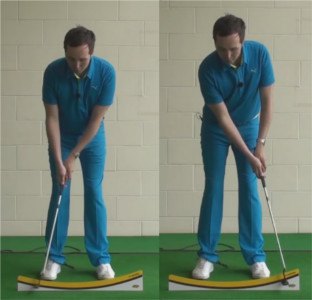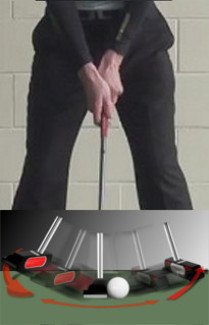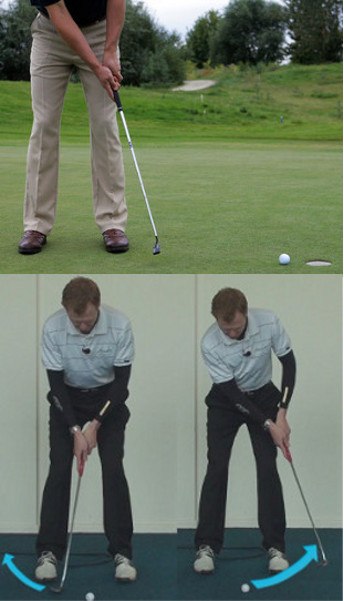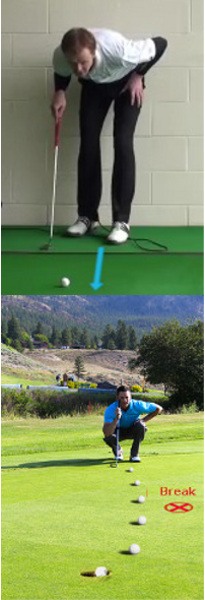
The technique for putting is very important.
Golfers very often underestimate the technique for putting as they practice their driving technique for the majority of the time they practice. Putting normally equates to about 40% of the overall shots played in a round of golf. When working on putting technique, the face angle at impact is the most important factor. The club face has roughly 85% influence on the direction the golf ball starts in. Making sure the face angle at impact is square is vital. To improve the face angle at impact, the golf grip has to be correct. The most common grip is the reverse overlap and here are the instructions to achieve this.
Key tip - Make sure the grip is straight to the club face and when you take hold of the club, maintain the square position of the club face.
- Place the hand closest to the target on the top of the grip with the palm facing the side of the grip and the back of your hand facing the target. Place your thumb down the centre of the putter grip which normally has a flat front to the grip. From there, hold the club in the fingers, not dissimilar to the normal grip, and place the hand on the side of the grip. As a check point, you should see your thumb is straight down the middle of the grip.
- The bottom hand is placed below the other hand nearer to the bottom of the grip. The fingers wrap around the club and the thumb of this hand is placed on the top of the grip in a straight line down the front.
- Bring both hands close together so that the top hand's thumb is covered by the bottom hand's pad near the thumb.
- The top hand's index finger is placed down the side of the fingers on the bottom hand so that you can see the index finger of the top hand closest to the target.
- You can also try placing your bottom hand index finger down the side of the golf club for control.
- Keep the hands relaxed and tension free. Aim to hold the golf club at about a 5 out of 10 grip pressure.
The path of the putter is naturally very important. The swing path can be straight back and straight through or have a slight arc to the stroke. There is no correct path, however the important thing is you can repeat the path over and over again. Find a stroke that works for you and suits your style and putter and stick to it.
Ball position - To promote the best possible ball roll, the stroke must be smooth and slightly upward hitting on the golf ball. To help to hit slightly on the way up, the golf ball should be placed just in front of the middle of your stance. From that position, aim to slightly press the hands forward at address to keep the putter face square at impact.
Keep the body quiet - Aim to keep the lower body very still and quiet. Make sure the action just comes from the shoulders rocking and reduce the wrist flick at impact.
Top tip - 'Listen to the golf ball drop in rather than watch it miss'. Keep your head still as the ball travel towards the target.

Best Techniques for Golf Putting
On the surface, putting would seem to be such a simple task. You only have to roll the ball along the ground toward a small hole in the ground. While you would love to make your first putt, it is usually okay to finish the hole with a two-putt – meaning you get two attempts to be successful. Even a small child can hit a decent putt with just a little practice, so this task should be no problem at all for an experienced adult. Right? Well, not so fast.
If you are an experienced golfer, you already know that putting is one of the greatest challenges that golf has to offer. It might seem like hitting a long drive down the middle of the fairway should be more difficult, or hitting a tricky bunker shot from a deep sand trap. However, it is often putting which gives the average golfer the greatest difficulty. For countless amateur players who would love to lower their scores, it is really their failures on the greens that are the biggest issue. Learn how to roll the ball consistently into the cup and this game will quickly become much, much easier.
In this article, we are going to highlight some of the best techniques you can use for putting. Some of these are physical techniques, while others focus on how you approach the mental side of this challenge. Both the physical and mental sides need to come together if you are going to putt at a high level with any kind of consistency. As you might imagine, learning to putt properly is going to take plenty of practice and attention to detail. You aren't going to get better at this part of the game by accident – only a commitment to bettering your craft is going to work in the end.
One thing to note before getting too far into this discussion is the fact that putting is the most individual of all the areas of this game. That means there are many different ways to get the job done. Sure, there are some basic fundamentals that most people should follow, but those aren't as important on the greens as they are in the full swing. If you can find a way to roll the ball into the hole that works for you – and falls within the rules of golf – you should go for it. The goal is a simple one, and that is to knock the ball into the cup in as few strokes as possible. We are going to provide a variety of tips in this article, but it will be up to you to decide which of these tips to take to heart, and which to leave behind. In the end, you will have built a custom putting solution that can take your game to a new level.
All of the content below is based on a right-handed golfer. If you happen to play left-handed, please take a moment to reverse the directions as necessary.

Three Key Physical Techniques
We are going to start off with three key techniques that most people would agree are the fundamental building blocks of a good putting stroke. It may be possible to putt well while not following one of these keys, but attempting to do so would not be advised. If you are looking for the shortest path to putting success, you are going to want to hit each of these three points. Fortunately, none of them are particularly complicated or difficult to execute. With just a little practice, you can have a sound putting stroke in place in your game. That doesn't mean you are going to be perfect on the greens, of course, but it will be a great place to start.
Without further delay, let's take a look at these three physical putting keys.
- Quiet hands and wrists. This is where it all starts. What most people call a 'pendulum' putting stroke really comes down to swinging the putter with your shoulders rather than with your hands and wrists. Using your wrists to move the putter back and through the ball might seem like the natural option at first, but you will soon learn that this is anything but a reliable method. It is hard to hit your putts a consistent speed when you use too much hand action, and you will likely struggle to hit the target line as well. By taking your hands almost completely out of the equation, things immediately get a lot easier. Your shoulders will be able to move the putter at a consistent speed, meaning you will have less trouble sending the ball the right distance. Also, there will be very little movement in the direction of the putter face as it swings, so you'll have less trouble finding your line. Nearly every top golfer in the world uses a pendulum stroke, and that is no coincidence. Learn how to putt the ball without actively using your hands and wrists and your performance is sure to take a step forward.
- Steady head position. You probably aren't surprised to see this fundamental on the list. When putting, your head should remain perfectly still from start to finish. Since you aren't making the aggressive motion that you have to make when completing a full swing, it should be easy to keep your head still. The only trouble will come right around the moment of impact, when many golfers are tempted to look up in order to see where the ball might be going. Needless to say, this can be a costly mistake. Picking your head up prematurely is going to cause trouble, as your entire upper body is likely to move and the path of the putter may be affected. Nothing is to be gained by looking up before you have hit the putt, as your eyes can do anything about the path of the ball anyway. Trust your stroke, keep your head down, and swing through toward the target with confidence.
- Flex in your knees. One thing about golf that many amateurs struggle to learn is just how important the lower body is in the overall scheme of your technique. Sure, it might be your upper body that is holding onto the club, but your lower body will have a lot to say about how successful you are on the course. That is true in the full swing, and it is true when on the greens as well. While putting, make sure to have your knees flexed from address all the way on through to the finish of the stroke. During the stroke, there should be no movement in your knees at all – you should be like a statue from the waist down. Putting with flexed knees will put you in a comfortable, athletic position which you can use to create a smooth stroke and a solid strike. Also, you will be less likely to sway off balance when your knees are flexed.
As you can see, each of these three putts has more to do with staying still than it does with moving part of your body. There is a great lesson to be learned in that pattern. As a general rule of thumb, you should be trying to use as few moving parts as possible when putting. Hitting good putts is all about being able to repeat your stroke, and the only strokes which repeat reliably are the simple ones. While working on your technique, do your best to take as many moving parts as possible out of your putting mechanics. In the end, you will be left with an extremely simple action that repeats itself nicely over and over again – even under pressure.

Some Mental Techniques
The physical keys listed above are widely agreed upon as a great way to roll the ball toward the hole. The mental keys you can use on the course, however, are far less universal. It seems that each individual golfer has his or her own way of putting the mind in the right place for optimum performance.
To help you come up with your own plan for a sharp mental game on the greens, we have provided some basic tips below. Review these ideas and decide which ones you would like to add to your own method.
- Every putt is a straight putt. This is a classic golf tip which can change the way you think on the greens. Right away, you are probably trying to figure this one out, as obviously not all putts are actually straight. In fact, most putts turn in one direction or the other. So what is this all about? Basically, the idea here is that you are going to think of your putts as being straight once you stand over the ball. You have already made your read and adjusted for that read by aiming to one side or the other. Now, as you prepare to hit the putt, you shift your thinking that imagine that the putt is a straight one. After all, the only thing you can do is hit the target line as accurately as possible – if the read was wrong, there is nothing you can do about it now. By thinking of your putts as straight putts, you might be able to quiet your mind and focus on the things you can control.
- Every putt is a lag. Many golfers get into trouble when they try to make all of their putts, no matter how difficult. You might find that your results improve if you lower your expectations and simply try to lag the ball up to the hole with each effort. For instance, instead of trying to ram that 15-footer into the back of the cup, you just pay attention to your speed and try to leave the ball right next to the hole for an easy tap in. You will still get one or two to fall in from time to time, but you'll also have plenty of simple two-putts. This can be a difficult mindset to adjust to when you are used to being aggressive, but give it a try before you write it off completely.
- Play more break than you see. This is one of the best mental techniques available on the greens. Amateur golfers tend to under-read their putts – badly. The average golfer doesn't play nearly enough break on long putts, and sometimes even on short putts. To counteract this fact of life on the course, simply add to your read each time before you settle on a final line and hit the putt. On a short putt, you might only need to add an inch or two to the read – on a long putt, it might be more like a foot. As you gain experience with this kind of thinking, you will start to see the true read much quicker, and you might not need to keep adding additional space to your final line. Always compare your read to your results on each putt so you can gain valuable information about your skills and development as a putter.
Thinking properly on the greens is just as important as making a good stroke. Putting has a way of getting in your head which is unlike anything else in this sport. You can expect to be a bit nervous while putting, and you can expect to have your mind wander into negative places. Don't let either of those things throw you off of your game plan. Stick with your plan from both a physical and a mental perspective, and do your best to remain confident even if you miss a few putts along the way.

The Art of Reading a Green
One of the things that no one seems to ever teach you in golf is how to read a green. If you take golf lessons, or if you just ask an experienced friend for help, you will hear all about things like swing technique, equipment, and maybe even course management. What you won't hear, however, is advice on how to properly read a green. You are just supposed to know how to look over the green and decide which way the ball is going to turn once it starts rolling. It probably shouldn't be a surprise that most golfers are pretty lousy at reading greens, considering how little this topic is discussed.
We are going to change that in this section. Below, we have listed several green reading tips which we hope will help you improve your skills in this area of the game. You might not be a master green reader immediately after putting these tips to use, but you should be at least pointed in the right direction.
- Take a look from both ends. Most golfers know that they should take a look at their putt from behind the ball before sending the shot on its way. What many players don't know, however, is that it is even more important to read a putt from behind the hole. In fact, that should be the first place you head when getting your read. Walk up to the hole, stand a few feet beyond on the hole on an extension of the line, and crouch down to get a good read. This is a valuable perspective because the slope at the end of a putt is more important than the slope at the beginning. The ball will be moving more slowly at the end, meaning it is going to break more than it did at the start. Get a great understanding of the slope of the ground around the hole and then build your read around that information.
- Read the vertical change. Getting a read on a given putt is not only about judging how much the ball is going to turn to the left or right – it is also about judging the speed of the putt. To know how hard you need to hit the ball, you first need to know how much uphill or downhill slope is involved in the putt. This information is best gathered from a position off to the side of the line. Walk to a point halfway between your ball and the hole, and position yourself a few feet to the low side of the line. Looking from this angle should make it easy to determine whether you are putting uphill or downhill overall.
- Adapt to new environments. One of the inherent challenges that comes along with reading greens is the fact that your green reading skills are going to have to adapt to each new course you play. Green speeds vary from course to course, meaning you will have to adjust your reads to match with the speed of the surfaces. Also, different strains of grass will cause the ball to respond in different ways. The best way to adapt to a new course is to practice reading your putts before the round even starts. Rather than just hitting a few putts as fast as possible on the practice green, take your time and read each putt before you send it on the way. Then, compare your read to what actually happened when you hit the putt. By making a few adjustments during the warmup session, you should be ready to make great reads all day long, starting on the very first hole.
Green reading is not a skill that you are born with. All great green readers had to start somewhere, and that somewhere is usually making some bad reads and learning from them over time. With plenty of practice and attention to detail, you can turn this part of your game from a weakness into a strength.

Get the Job Done Under Pressure
Putting well when there is nothing on the line is challenging, but it is a challenge which most people can overcome thanks to proper technique. The challenge goes to a new level, however, when there is something on the line. For instance, if you decide to play in a tournament at your local club, you will quickly realize that golf gets a lot harder when you are nervous. And nowhere on the course do those nerves have a greater effect than when you are on the greens.
So how do you putt well when you are nervous? The first step is to stick with your routine. You should do the same things that you always do, including reading the green the same way and taking the same number of practice strokes. Don't try any harder just because there is something on the line – do what you always do for best results. Golf is not a game which rewards extra effort in most cases. Rather, it is a game which rewards consistency and discipline.
The other key to putting well under pressure is to slow yourself down before hitting each putt. It is natural to move faster under pressure, and doing so is going to cause you to make mistakes. You might hit your putts too hard when moving quickly, or you may pull them to the left thanks to overactive hands. Before you hit a putt under pressure, take a deep breath and focus your mind on the task at hand. Set the consequences of the putt to the side and think only about rolling the ball perfectly up toward the cup.
Nothing we can say in this article is going to magically turn you into a great putter. You are only going to improve your putting performance through a combination of hard work and attention to detail. Over time, the work you put in on the practice green should start to show up on the course in the form of lower scores. We hope the putting tips provided throughout this article will help you take a big step toward improved scoring. And, of course, we hope you have more fun playing this game as a result. Good luck!





